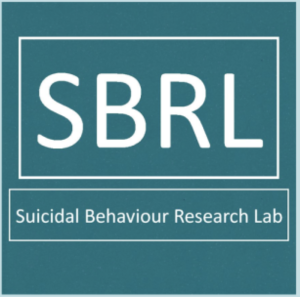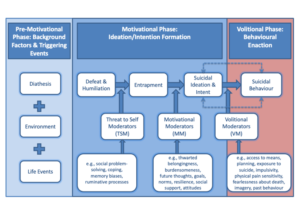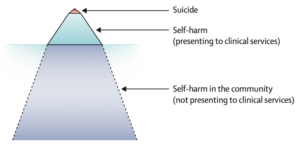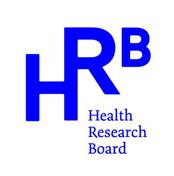
My name is David McEvoy and I am a SPHeRE PhD scholar based at the Royal College of Surgeons in Ireland (RCSI) in Dublin. My PhD focuses on the epidemiology of self-harm in young people – in particular, on the pathways to self-harm and suicidal behaviour in adolescents and young adults.
I recently completed my international work placement as a visiting researcher at the Suicidal Behaviour Research Laboratory (SBRL) at the University of Glasgow, led by Professor Rory O’Connor, the President of the International Association for Suicide Prevention (IASP). The SBRL is an interdisciplinary research team that conducts experimental research, clinical and non-clinical studies as well as psychosocial interventions and applies theoretical models derived from different areas of psychology as well as from the social sciences to enhance the understanding of self-harm and suicide 1.
One of the key theoretical models used by the SBRL, proposed by Professor O’Connor, is the Integrated Motivational-Volitional (IMV) Model of Suicidal Behaviour. In brief, this tripartite model proposes that suicidal behaviour results from a complex interplay of different factors, and intention to engage in suicidal behaviour is determined by feelings of entrapment where suicidal behaviour is seen as the salient solution to life circumstances 2.

The Integrated Motivational-Volitional (IMV) Model of Suicidal Behaviour 2
I got to know some of the team at the SBRL since I had previously presented my work at their Suicide and Self-Harm Early and Mid-Career Researchers’ Forums in Glasgow in June 2022 and 2023, and will again present at their eighth meeting in June 2024. This meeting was a great opportunity to hear from experienced researchers in the field of suicide and self-harm research and to meet other newcomers to the field like myself.
In April this year, I visited the SBRL for two weeks. This was a great opportunity to learn about the various research projects being conducted by the team. One particularly interesting project was the implementation of the Distress Brief Implementation (DBI) programme, which provides inter-agency co-ordination, collaboration and co-operation across a wide range of care settings, interventions and community supports, towards the shared goal of providing a compassionate and effective response to people in distress 3. DBI Level 1 training is provided by the University of Glasgow for front line workers such as NHS24, Scottish Ambulance Services, and Police Scotland to provide a compassionate response and involves an offer of a seamless referral to a DBI Level 2 service 3. The DBI Level 2 service is provided by third sector staff who contact the person within 24-hours of referral and provide compassionate, problem solving support, wellness and distress management planning, supported connections and signposting for a period of around 14 days – reducing both immediate distress and empowering ability to manage future distress. The person’s GP is notified of the outcome of referral by the DBI service 3.
Another very interesting project that I learned about during my time at the SBRL was the Schools Health Research Network in Scotland (SHINE). The SHINE network collects adolescent health and well-being data from over 700 schools all over Scotland for monitoring and planning purposes. As a former secondary school teacher studying a PhD in self-harm in adolescents, I found it fascinating how the SHINE network is establishing mechanisms for linking educational and health data for mental health in adolescents.
As well as learning about the myriad of interesting projects being conducted by the SBRL, I also had the opportunity to present research from my PhD to the team and get some critical feedback from experts in the field.

Group photo with the SBRL team after presenting PhD research to the team
Self-harm is the deliberate injury to oneself, regardless of whether the motivation is suicidal or not. There is a multitude of common methods for self-harm such as overdosing, self-cutting, self-battery, attempted hanging, attempted drowning to name a few. An iceberg model is often used to describe the epidemiology of self-harm and suicide. For every death by suicide (the peak of the iceberg), there are many more suicide attempts or incidents of self-harm that are reported to the clinical services and so are visible above the surface 4,5. Incidents of self-harm in the community that are not reported to clinical services vastly outnumber those that do present to clinical services and are, hence, hidden beneath the surface 4,5.

The iceberg model of self-harm (Source: Hawton, Saunders and O’Connor 2012) 5
Suicide is the fourth leading cause of death in 15-29 year olds globally 4. In 2019, suicide was the leading cause of death in males under 25 years old and the third most common cause in females of the same age in Ireland 6. Self-harm is the most important risk factor for a later death by suicide. My PhD on the pathways to self-harm in adolescents and young adults focuses on identifying high-risk groups of adolescents both at clinical and community levels, above and below the surface. Knowledge of these groups can inform clinicians as well as other professionals who work with young people, such as teachers, university staff or social workers, in community settings 7. On a public health level, these groups could inform the implementation of interventions that could identify at-risk individuals for their referral to appropriate psychiatric services or advance other more population-based methods, like anti-bullying measures in schools for example, that could potentially reduce self-harm 7.
References:
1 Suicidal Behaviour Research Laboratory. Available at: https://suicideresearch.info
2 The Integrated Motivational-Volitional (IMV) Model of Suicidal Behaviour. Available at: https://suicideresearch.info/the-imv/
3 Distress Brief Intervention. Available at: https://www.dbi.scot/aim/
4 World Health Organization. Suicide: Key Facts Geneva: World Health Organization; 2021 [updated 17/06/2021; cited 2022 04/04/2022]. Available from: https://www.who.int/news-room/fact-sheets/detail/suicide
5 Hawton K, Saunders KE, O’Connor RC. Self-harm and suicide in adolescents. Lancet. 2012;379(9834):2373-82.
6 Central Statistics Office. Suicide Statistics 2019. Available from: https://www.cso.ie/en/releasesandpublications/ep/p-ss/suicidestatistics2019
7 McEvoy D, Brannigan R, Walsh C, Arensman E, Clarke M. Identifying high-risk subgroups for self-harm in adolescents and young adults: A longitudinal latent class analysis of risk factors. Journal of Affective Disorders. 2024;351:40-8 https://doi.org/10.1016/j.jad.2024.01.230

